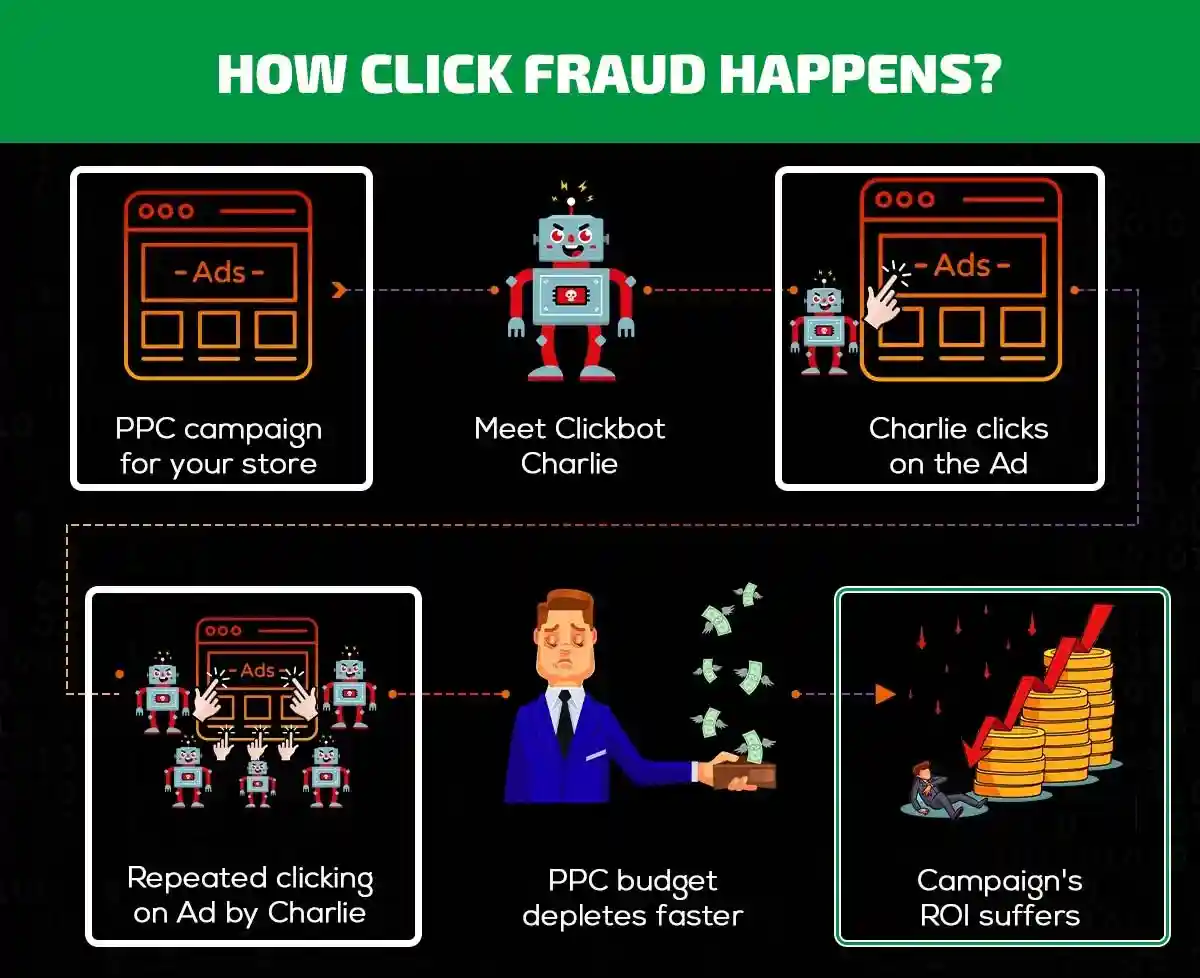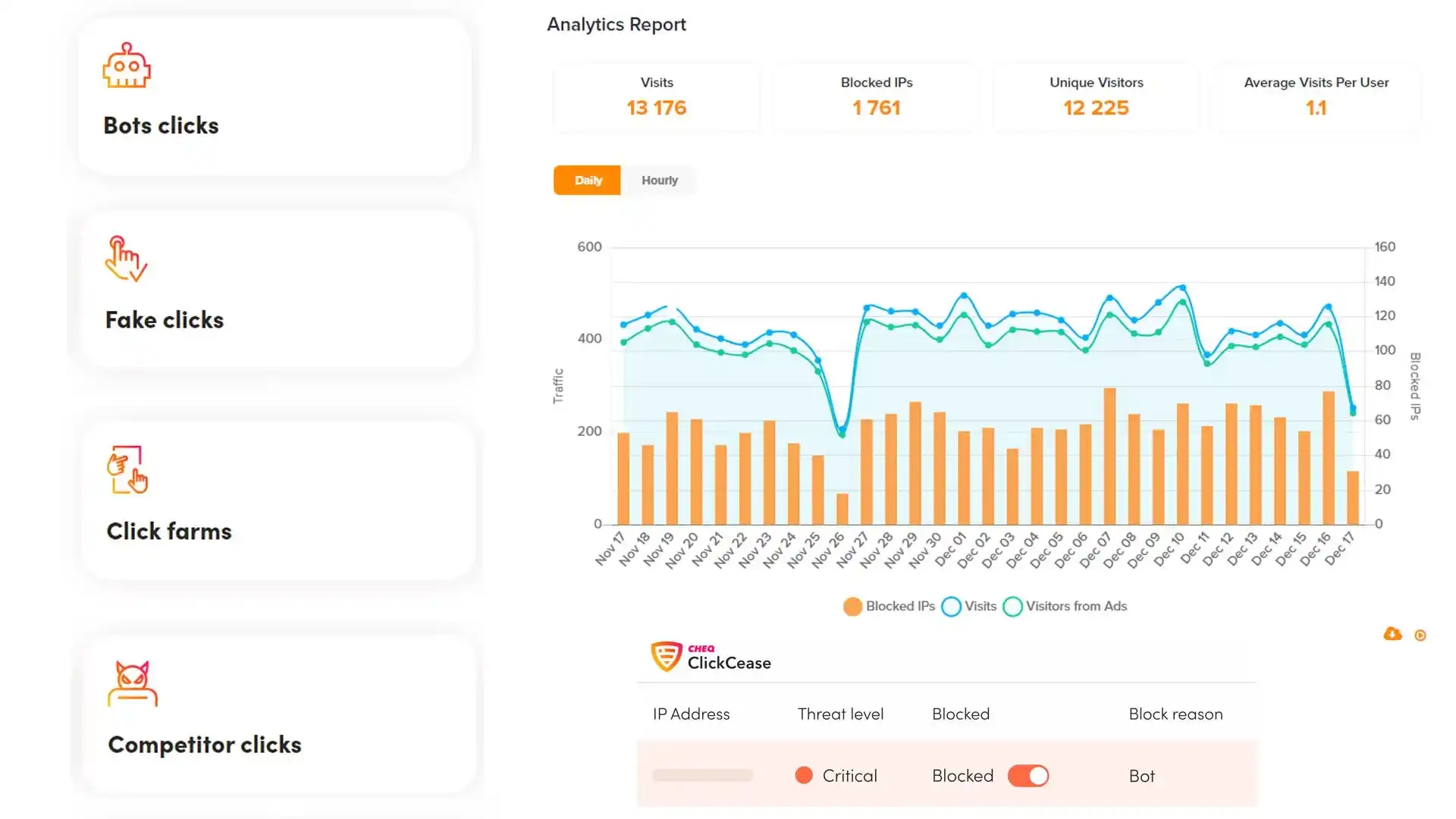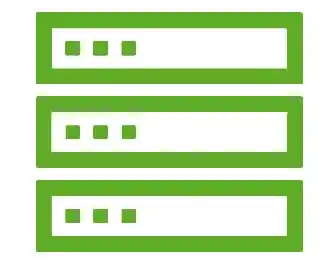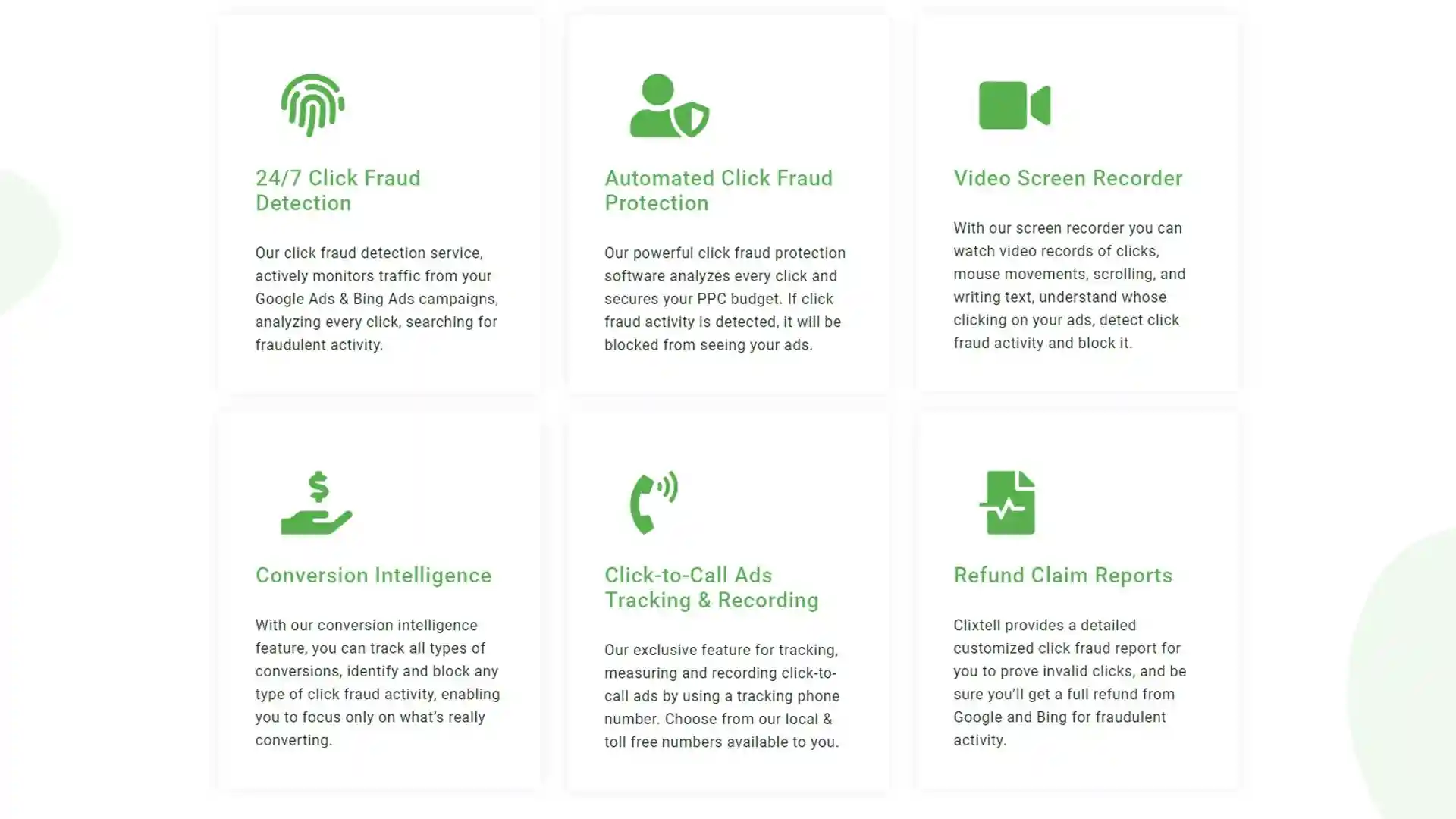
Click fraud is a type of fraudulent behavior in which pay-per-click ads of a company are clicked on with no intention of converting and without yielding any type of results. These actions are usually done by bots or competitor sites in order to exhaust the advertising budget of a company. 
The result of such fraudulent behavior is also that the statistics of the traffic of the site become unreliable, skewed, and artificially tampered with. This can have further consequences on the company’s future attempts at launching marketing campaigns.
Another consequence of falling victim to click fraud is that a company in charge of running the ads might lose the trust and loyalty of its customers.
Another point worth noting is that accidental clicks, while not actually considered a type of click fraud, do yield similar destructive consequences. You would be surprised to find out just how common it is for users to accidentally click on a link. And because the action was accidental and they have no intention of browsing the site, they simply exit the page.

This also harms sites. And while this particular type is not intentional, the consequences of it are still negative, and they can be alleviated by using intelligent Google ads click fraud prevention tools.
Accidental clicks are so common, in fact, that they are under the umbrella term of invalid clicks. Invalid clicks are usually committed without malicious intent, although the definitions of fraudulent and invalid clicks may often overlap.

Bots are the most common sources of click fraud. As the name suggests, bots will continuously click on links until the marketing budget is completely drained. Bots are so efficient that the process can be over within just a few hours after the ad has been launched.

Farms are people who are hired to carry out these attacks instead of bots. They may be less efficient, but they appear less dodgy and may therefore pass through the search engine’s primitive protection mechanisms.

Competitors may seek out to drain your budget by doing the work themselves or launching the bots or farms against you.

In relation to the farm and competitor attacks, some sources may use VPN services to try and evade being detected by the search engine’s protection software.

Another possible reason for launching these malicious attacks is that the revenue of the website hosting the ad increases while the advertiser loses their budget with no returns. The profiting party may be behind the attacks or at least facilitate them.

filters out the bots, the fishy IP addresses, the VPN sources, anyone with suspicious activities, and so on. This is the simple way in which your ads are protected from falling victim to such a devastating and complicated issue.

The main difference between fraudulent and non-fraudulent clicks has to do with intent and action.
Non-fraudulent clicks are those that are generated by actual people with real interest in the website’s services and products.
These types of clicks may often result in sales. On the other hand, fraudulent clicks do not.

As was just implied, fraudulent clicks are those that result from malicious attacks. They do not result in sales, and the entities generating these clicks have no interest in what the site is offering.
You’re probably wondering how this built-in protection works and whether it is effective at all.

The short answer is that it is not very effective, and here’s why:
Simply put, the search engine’s built-in protection works to detect patterns and filter out suspicious activity. This might seem like the ideal way to go about this, but unfortunately, it is not as advanced as it needs to be.
The suspected reason behind why Google doesn’t put in a greater effort into this is that it is, after all, profiting from those clicks as well, even the fraudulent ones. Statistics also prove that fraudulent clicks are on the rise, with no sign of slowing down.

In 2020, profit loss from fraud clicks were estimated to be around 35 billion USD globally. While in 2023, that number was closer to a staggering 61 billion USD.
The problem is a lot more serious than one might think, and Google’s efforts to stop click fraud in Google ads are clearly not enough. This is where protection software comes in handy.
Click fraud detection and protection software systems automate the process of filtering out malicious activity to safeguard you from click fraud as much as possible.
As we just discussed, search engines do not do the best of jobs in preventing you from falling victim to attacks of fraud clicks. This, coupled with the devastating consequences of those attacks, is enough reason to employ a better software detection and prevention system.
The reason why the ready-made systems work better is that they use more intelligent and advanced software that is constantly deployed in the protection of Google ads.

The advanced system scans the IP address and the browsing environment of every user who clicks on the ad. If anything is deemed suspicious, then the IP address is automatically blocked, and will no longer be able to view the ad.
Using a VPN does not help evade an intelligent protection system as the device ID from which the click came from is detected, and not just the IP address. Recurrent clicks from one device will also be flagged.
So, as you can see, many more methods of detection and prevention are used, ultimately rendering ready-made systems marginally more effective.

The most obvious measure to take to efficiently deal with invalid clicks is using an ads invalid click protection system. However, there are definitely some measures that you can take from your own side.
Firstly, you can manually look into the statistics of clicks and sift through them in an attempt to identify any suspicious activity. Suspicious activity can be in the form of a sudden influx of clicks at a particular time, IP addresses from odd locations, and so on.
This process can help you manually block IP addresses.
Moreover, one way to handle bots is to integrate a human verification process.
You should also be wary of which sites you choose to advertise on. And if you do fall victim to click fraud, you should gather as much evidence as possible and report the incident to the site or to Google. While this won’t undo the damage that was done, it might prompt the website or the search engine to employ better protection methods.
In the end, as you can see, the majority of these efforts seem time-consuming and not as efficient as they should be. This is why it is best to let a ready-made automated system handle it for you to ensure that the job is done right.

Firstly, look into the ease of use of the program. There should also be some room for customization. Perhaps you need certain services more than others, and it should be fine-tuned according to your needs. On a related note, you can make sure that the software has been used in your field before, which ensures its effectiveness.
You can also look into the statistics of the protection service to find out its success rate. Further, look into how well the data management of the service is and whether or not analytics are offered so that you can be well-informed and involved in the process.
A well-established service should also have a support system in place for users of the software. A thorough explanation of how the software works should also be offered. You should also understand how promptly the software takes action against any detected fraud and how ‘intelligent’ it is at adapting.
Of course, factor in the cost to make sure it is within your budget, and do read reliable reviews of other companies’ experiences with the service.

Final words on Google AdWords click fraud protection systems
As we already mentioned, click fraud is an ill-intended click on your ad with no intention of browsing the site or making a purchase. The intention is often to knock you off the ad spot, make you lose money on pay-per-click ads, and yield you no profit from money spent on advertising.
So, in conclusion, the verdict remains solid – a proper Google AdWords click fraud protection system is a must. Without it, chances are that you will fall victim to a multitude of click fraud attacks of different kinds, from bots being sent your way to competitors trying to bring you down.
And with the devastating consequences of the attacks, from financial loss to loss of trust of clients, the attacks should be stopped.
An automated click fraud protection service that is on a constant lookout for fraud clicks, has intelligent methods of detecting fraud that stretch beyond Google’s protection system, and does an excellent job at preventing the attacks is exactly what you need to keep your ads safe and maintain their effectiveness.
Stay safe out there!
You can manually monitor the clicks and try your best to detect suspicious activity to block IP addresses.
But the best solution is to deploy a click fraud protection software that automates the process and does a much better job at detecting fraudulent activity and stopping it.
A protection software can automatically detect click fraud and instantly put a stop to it.
Click fraud can be detected by analyzing data in search for suspicious activity. Suspicious activity includes a sudden spike in clicks, weird IP addresses, multiple clicks from the same device, and so on.
A protection software can block a fraudulent IP address instantaneously. A protection software can even go above and beyond to detect the device ID and not just the IP address. This means that it can understand if a VPN is in use.
Multiple clicks from the same device ID (even under different IPs) are still flagged.
Technically speaking, the protection software is on guard 24/7 analyzing the data of the clicks. It collects information about each and every click. Information includes location, IP address, device ID, and more.
The information is thoroughly analyzed in real-time to find any suspicious activity to block sources of fraudulent clicks, therefore preventing further clicks from that source. It also checks patterns to become smarter at detecting and stopping future fraudulent clicks. All this happens instantaneously.
With overwhelmingly positive reviews, thousands of trusted advertisers, and a reliant customer support service that takes user feedback into consideration, you can rest assured that the protection will keep your ads safe and secure.
Click fraud protection covers all possible types of attacks, as it is equipped with an intelligent software that is specifically designed to detect them and learn patterns to increase its effectiveness at detecting and stopping fraud.
This includes protection against bot attacks, automated clicks, organized manipulations, and more.
Min price 15$
Prices differ significantly based on the tier you choose to opt for. With each tier, you can get coverage on more platforms, more websites, against more clicks, more thorough reports, and more in-depth competitor ad analysis, and you can even get additional features like web forms and purchases tracking, account review, account management, and other custom security rules.
You can surely customize each package to suit your specific needs. Contact the support system to learn more about the price range that you should expect for your needs.
To minimize the negative impact as effectively as possible, the system’s response to potentially harmful clicks is instantaneous.
Considering the sensitivity of click and visit information, the data is kept securely and is not shared with third parties.
Upon termination of the contract between the provider of the protection software and the user, the data is deleted.
There is an option of a free trial that is available for organizations who wish to test the system and its effectiveness before a full implementation.
We understand how crucial support services can be, especially in case of issues or malfunctions in the system.
For this reason, support services are available, and they are offered on a 24/7 basis.